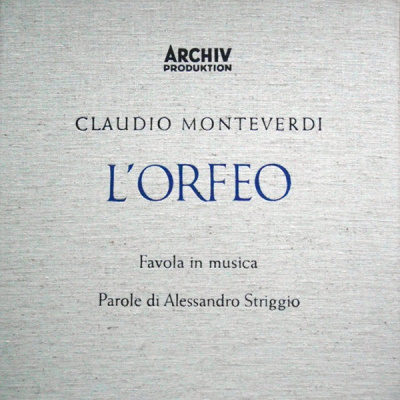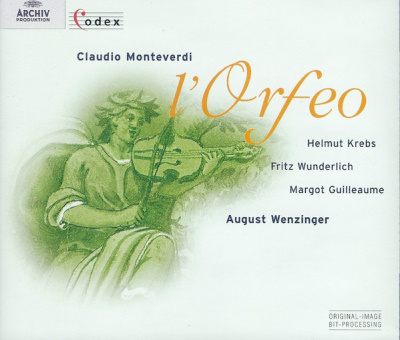 |
|
2 LPs
- 14057/58 APM - (p) 1955
|
 |
| 2 CDs -
453 176-2 - (p) 1997 |
|
IL SEICENTO
ITALIANO
|
|
|
|
|
|
|
|
| Claudio
MONTEVERDI (1567-1643) |
L'Orfeo
(1607) |
|
97' 52" |
|
|
1.
Toccata
|
|
(0' 40")
|
A1 |
|
2.
Prologo: "Dal mio Permesso amato" |
|
(5' 23") |
A2
|
|
Atto primo |
|
(17' 04") |
|
|
3.
"In questo lieto" |
1' 40" |
|
A3 |
|
4.
Coro di Ninfe e Pastori: "Vieni, Imeneo" |
1' 10" |
|
A4 |
|
5.
"Muse, onor di Parnasso" |
0' 50" |
|
A5 |
|
6.
Coro di Ninfe e Pastori: "Lasciate i
monti" |
2' 12" |
|
A6 |
|
7.
"Ma tu, gentil cantor" |
4' 01" |
|
A7 |
|
8.
Coro di Ninfe e Pastori: "Lasciate i
monti" |
1' 08" |
|
A8 |
|
9.
Coro di Ninfe e Pastori: "Vieni, Imeneo" |
1' 07" |
|
A9 |
|
10.
"Ma se il nostro gioir" |
5' 03" |
|
A10 |
|
Atto secondo
|
|
(23' 50") |
|
|
11.
Sinfonia I - "Ecco pur ch'a voi ritorno" |
6' 50" |
|
B1 |
|
12.
"Ahi, caso acerbo" |
8' 44" |
|
B2 |
|
13.
Coro: "Ahi, caso acerbo" |
8' 21" |
|
B3 |
|
Atto Terzo
|
|
(24' 40") |
|
|
14.
Sinfonia II |
1' 00" |
|
C1 |
|
15.
"Scorta da te" |
6' 13" |
|
C2 |
|
16.
Sinfonia III - "Possente spirto" |
9' 26" |
|
C3 |
|
17.
"Ben mi lusinga" |
4' 03" |
|
C4 |
|
18.
Sinfonia II - Coro di Spiriti: "Nulla
impresa per uom" |
3' 48" |
|
C5 |
|
Atto quarto |
|
(12' 31") |
|
|
19.
"Signor, quell'infelice" |
5' 35" |
|
D1 |
|
20.
"Ecco il gentil cantore" |
5' 26" |
|
D2 |
|
21.
Coro di Spiriti: "E' la virtute un raggio" |
1' 30" |
|
D3 |
|
Atto quinto |
|
(13' 44") |
|
|
22.
"Questi i campi di tracia" |
7' 46" |
|
D4 |
|
23.
"Perchè a lo sdegno" |
5' 58" |
|
D5 |
|
|
|
|
Helmut
Krebs, Orfeo
Hanni Mack-Cosack, Euridice
Margot Guilleaume, Musica /
Proserpina
Jeanne Deroubaix, Speranza /
Messaggera
Hildegard Wild, Ninfa
Horst Günter, Plutone
Peter Rot-Ehrang, Caronte
Bernhard Michaelis, Pastore I
Fritz Wunderlich, Apollo / Pastore
II / Spirito II
Peter Offermanns, Pastore III /
Spirito I
Clemens Kaiser-Berme, Pastore IV /
Spirito III
|
Chor der
Staatlichen Hochschule für Musik,
Hamburg
Instrumentalkreis der "Sommerlichen
Musiktage Hitzacker 1955"
Instrumentalisten:
- Ulrich Grehling, Rodolfo Felicani, Violini
piccoli und Violine I
- Dieter Vorholz, Otto Schaernack, Violine
I
- Maria Leonhardt-Amsler, Gertrud
Eggers, Violine II
- Ilse Brix-Meinert, Rosemarie Lahrs,
Viola I
- Robert Haass, Viola II
- Jan Crafoord, Viola da gamba I
- Josef Ulsamer, Viola da gamba II
- Johannes Koch, Angelo Viale, Kontrabaßgambe
- Gustav Scheck, Thea v. Sparr, Blockflöte
- Otto Steinkopf, Heinz Döring, Zinken
(Cornett)
- Harry Barteld, Altposaune
- Gustl Tientz, Adam Rutthoff, Günter
Grätzig, Tenorposaune I, II, III
- Alfred Stönenberg, Baßposaune
- Adam Zeyer, Franz Josef Clemens, Trompete
Continuo:
- Fritz Neumeyer, Gustav Leonhardt,
Cembalo
- Kurt Heinz Stolze, Positiv
- Volkert Lübsen, Positiv und
Regal
- Klaus Storck, Violoncello
- Hannelore Müller, Viola da gamba
- Gerd Ochs, Fritz Seidemann, Chitarrone
- Clothilde Depenheur, Harfe
- Johannes Koch, Kontrabaßgambe
August WENZINGER, Dirigent
|
|
|
|
|
Luogo
e data di registrazione |
|
Beethoven-Saal,
Hannover (Germany) - 25/30 Luglio
1955
|
|
|
Registrazione:
live / studio |
|
studio |
|
|
Produzione |
|
Dr. Fred Hamel |
|
|
Recording
Engineer
|
|
Harald Baudis
|
|
|
Prima Edizione
LP |
|
Archiv | 14057/58 APM
| 2 LPs - durata 46' 57" - 50' 55"
| (p) 1955 | Mono
|
|
|
Edizione CD |
|
Archiv Produktion
"Codex" | 453 176-2 | 2 CDs -
durata 47' 32" - 56' 44" | (p)
1997 | ADD | Mono
|
|
|
Cover Art
|
|
-
|
|
|
Note |
|
Sommerlichen Musktage
Hitzacker 1955
|
|
|
|
|
On the 24nd
Febraury 1607 a group of
brilliant and erudite people
assembled at Mantua to
witness the first
performance of the "Favola
in Musica", by the court
musical director of the
noble house of Gonzaga,
Claudio Monteverdi, who was
then forty years of age and
was already one of the most
eminent musicians of
northern Italy. The audience
were justified in expecting
something noteworthly, and
they were not disappointed.
"Orpheus" proved itself to
be neither a pompous
spectacle with music like
those customary at courtly
entertainments, nor a
musically rather arid
melodrama in the style
evolved a few years
previously in Florence, but
a hitherto unique mixture of
the two. True, it was a
drama set word for word to
music, like its Florentine
predecessors, but there was
none of the slavish
subortination of music to
text which had weakened the
earlier operas. Monteverdi
employed all the means
available to him: the old
polyphonic style used side
by side with the new single
voice technique, and all the
wealth of instrumental
effects known at that time.
These various elements were
not brought into play
haphazardly or for their own
sake, as in the old festive
works, but solely for the
purposes of the drama.
"Orpheus" is therefore a
music drama, the first in
musical history, although
from a textual point of view
it is merely a more lyrical
than dramatic Pastoral in a
style common at that time.
Orpheus and Eurydice appear
in the first act among the
carefree shepherds and
nymphs as among their own
kind, and in the second act
a nymph brings Orpheus the
news of Eurydice's death.
The two following acts, set
in the Underworld, contain
virtually all the dramatic
action: the winning over of
Charon, the reunion of
Orpheus and Eurydice, and
the final tragedy of
Eurydice's second death. The
lyrical fifth act, Orpheus'
"Lamento", returns to the
pastoral scene of the first
and second acts, with as
little action.
This division of the work
into two clearly defined
sections exercised a strong
influence on Monteverdi in
his choice of instrumental
colours. He paints the
idyllic scenes on earth,
with their nymphs and
shepherds, by means of the
gentle tones of flutes,
strings, harpsichord and
organ: the Underworld is
depicted by the
awe-inspiring tones of
trumpets and trombones, with
a portative organ as
continuo. The hero Orpheus,
with his characteristic
music, appears in both parts
of the work. The brightness
of the scenes on earth is
characterized by a species
of lyrical recitative,
alternated by short strophic
songs, madrigalesque choric
dances, and lively, rhythmic
orchestral interludes. These
varied elements combine to
create the idyllic
atmosphere of the pastoral
scenes. The happy mood is
destroyed at a blow with the
news of Eurydice's death. At
the entrance of the nymph
bringing the tragic message
in the middle of the second
act it is as though the door
to another world were
opened. The gently flowing
lyrical declamation hitherto
employed is now no longer
able to bear the emotional
burden of the situation. A
more dramatic mode of
expression is called upon,
the vocal line becoming more
forceful, the harmony taking
on a new tenseness, with
astonishingly sharp
dissonances. In short, all
formal considerations are
treated as being of
secondary importance to the
music's primary purpose of
creating in the spectators
the most potent emotional
feeling possible. A
psychological masterpiece
and a highspot of the opera
is the short dialogue of
questions and answers
between the Messenger and
Orpheus, the message of
Eurydice's death itself, and
the despalring cry "Ohimè"
with which Orpheus reacts to
the news. This impassioned
dramatic declamation
(especially impressive in
the narration of Eurydice's
death, in the lament of
Orpheus which follows it, to
the expression of his
anxiety on behalf of his
regained and then
irrevocabily lost Eurydice,
and in his final "Lamento"
in the fifth act) is
alternated, in the scenes in
Hades, with pathetic
choruses and solemn, ominous
instrumental interludes. a
born musical dramatist,
Monteverdi knew that a
continuous state of
emotional tension would tire
the soectators. He therefore
introduced not only
straightforward declamatory
passages into the
recitative, but also on out
and out comic part, that of
the ferryman Charon in the
third act. Even Orpheus'
great vocal solo "Possente
spirto, e formidabil nume",
in which he employs all his
wonderful art as a singer,
does not disturb the rough
Charon from his stupid
self-satisfaction.
Monteverdi's "Orpheus" ist
the earliest real music
drama, that is to say the
first work in which the
music is entirely one with
the dramatic idea, but both
the music and the idea
itself are far removed from
anything to which modern
audiences are accustomed,
and it is necessary to make
an effort to see the work
from the viewpoint of the
period at which iy was
written if the full measure
of its greatness is to be
appreciated. All that later
generations have achieved
with powerful
musical-dramatic situations,
novel instrumental effects
and huge orchestral forces,
had its origins in the
achievement of the operatic
genius Claudio Monteverdi,
who used all that he found
serviceable of the resources
available to him, with the
enthusiastic approval of his
more enlightened
contemporaries. We only need
to understand how to listen
to his music - then it is a
revelation!
Anna
Amalie Abert
|
  |
|
|